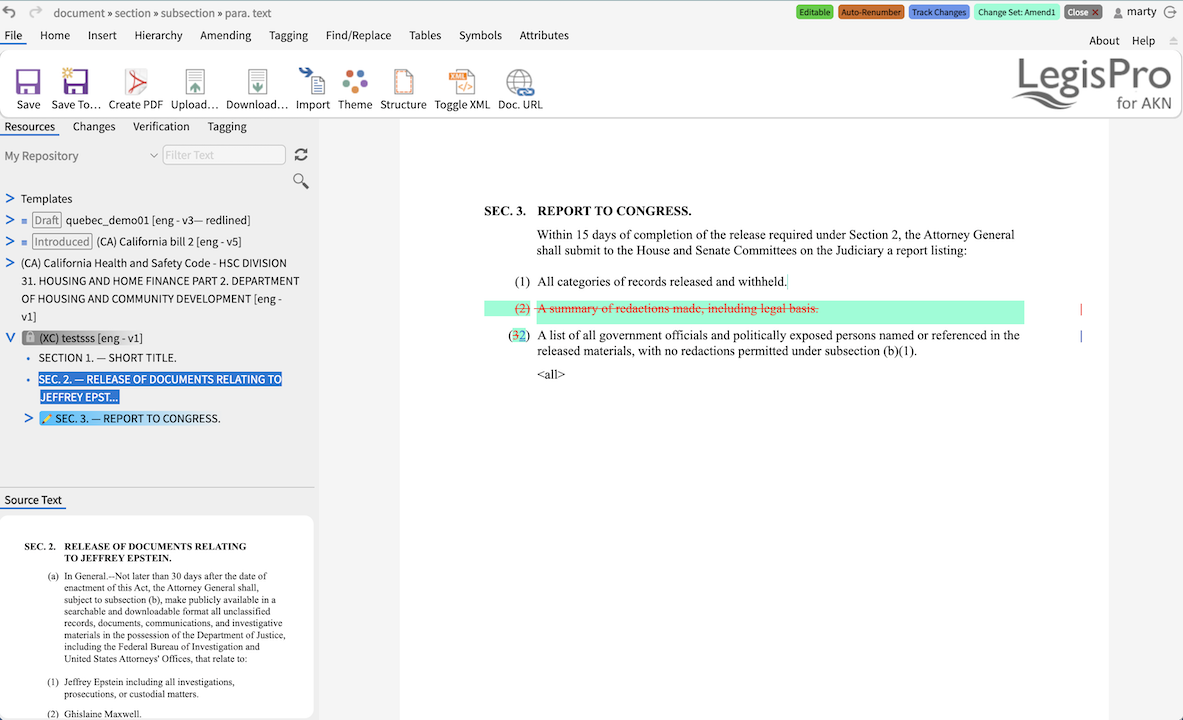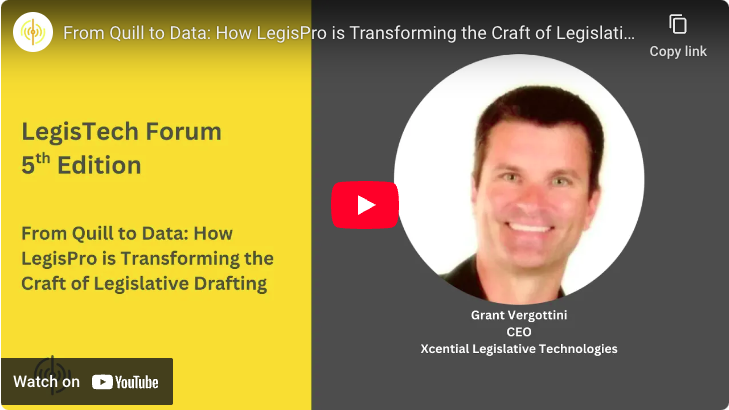Provisioning a Legislative Drafting Solution
November 1, 2024


National and sub-national governments are looking to provision legislative drafting solutions. And each democratic government has its own requirements, its own procedures, and traditions.
This guide is for government officials and legislative professionals involved in procuring or upgrading legislative drafting systems. We’ll discuss the essential values, constraints, and features to consider when making these important decisions.
Tenders and RFPs outline visions of new systems that match the old and embrace the future.
Xcential, for 20+ years, has consulted with democratic governments and parliaments on legislative and regulatory systems across our globe. We want to share what is being considered and what should be considered when implementing these meaningful systems.
These are meaningful systems. These legislative drafting solutions embody the rule of law and democratic values. Without careful stewardship of law, even long standing democratic governments can fall to “rule by law” or “rule of power”.
Values when Provisioning a Legislative Drafting Solution
Before we outline features, it is important to center our decisions in values. Legislative systems are not solely about financial outcomes, but shared values. These values must align to justify budget and effort.
- Transparency and Accountability. Knowing what is changing, who is changing it, and when it will change is necessary for voters. Better systems aid democracy by exposing how the individuals we vote for are actually representing us. As the media habits of citizens evolve, our systems must keep pace.
- Improving Public Services. Citizen engagement with government services is prescribed by law or policy and changes. Modern systems ease the burden of communication and enhance the efficiency and accessibility of the services we pay for. Modern systems also reduce the operational and bureaucratic burdens on government, making our tax dollars go farther.
- Economic Development. Well designed law and regulation are economic development; designed to create a well balanced playing field that serves the needs of citizens. Well designed legislative and regulatory systems create clarity and reduce economic uncertainty.
Xcential strongly believes in these values, and they should be honored.
Parameters and Constraints when Provisioning a Legislative Drafting Solution
We share and protect our values, but we must also work within parameters and constraints. Democratic governments and our dedicated civil servants have a responsibility to make good decisions in the context of the real-world; here are just a few examples.
- Budget. Citizens are paying, so how money is invested matters. It is expected and respected that any investment into a legislative or regulatory drafting system is effective and efficient but without sacrificing values or necessary features.
- Time. How long will it take to implement a new system? Will it be available before the next legislative session? When approvals are given for new systems, they are expected to be available within a time period and are expected to last for long periods of time.
- Technology. Technology is not just about features. Take for example, AI has lots of desirable features in legislative drafting relative to research, clarity of text, generative text; but AI comes with supply-chain issues which cannot be swept aside. Consider the value of transparency when considering AI. Security is a part of the technology constraint. Existing infrastructure is a parameter. Choosing the right technology affects budget, time, security, maintenance, and change management.
- Change Management. Many civil servants who manage legislative counsels have been doing their work with the same tools for many years. Successful introduction of new systems requires successful change management. For example, if a lawyer is unwilling to change from Wordperfect or MS Word, then this will constrain your technology choice. Change is never easy, but training and ongoing user support can make it easier.
- Interoperability, Standards, and Practice. New, modern systems are expected to communicate with one another. Standards like LegalDocML, Akoma Ntoso, and USLM are rightly considered a parameter. These standards create interoperability within our documents and statues and with our partners for alignment. These standards also enable component-oriented system design to positively affect budget and change management. Europe and Africa are adopting LegalDocML and Akoma Ntoso; while the United States federal government is centered on USLM (closely related to Akoma Ntoso). We will see these standards become highly adopted by sub-national governments in the coming years.
Features when Provisioning a Legislative Drafting Solution
With our values as a North Star and our understood parameters and constraints, we can now focus on features.
Our systems are as good as the features they provide to users. Below are the common features we see expected by democratic governments moving into a modern legislative system.
- Open Source Frameworks and Tech Stacks. Government systems should be configurable and customizable. When implementing a system of record (that literally handles the law), it is prudent to invest in a system that can be maintained independently and can evolve with future needs. Open source is future-proofing and critical in technology transformation.
- Cloud or On-Premises. Recently, more governments are willing to accept cloud-based solutions but they are expected to be hosted in a secure and controlled environment. Customization is a factor, so most governments are not ready to trust a multi-tenant SaaS solution for their legislative counsel.
- Intuitive Drafting Interface. To solve for change management, the application used for drafting should look and feel like a word processor. Some adjustment from WordPerfect or MS Word is expected, but it shouldn’t feel like you’re writing code. When implementing UI, the approach should emphasize user-centered design with usability testing throughout the configuration process.
- Templates. Because we require LegalDocML (or an equivalent) and because rules dictate how a bill or amendment is structured, we want drafters to start with templates. Templates help the overall system work and keep your staff reinventing the wheel. Templates should be controlled and editable.
- Easily Add Content. Every system should have a repository of law, statutes, and regulation to amend. Every system should also allow drafters to copy text into drafting templates with the confidence that our structures remain intact. However, we do want to avoid translations from DOCX XML to our standards because this usually performs poorly.
- Versioning. Amendments and bills will go through numerous revisions and we need easy ways to revert back to point-in-time versions for control. Versioning should be automatic.
- Track Changes. Track changes to relate directly to LegalDocML. This means that when changes are made, they are stored in the document in such a way that allows for streamlined compilation and amending language automation later. Tracked changes as part of amending in context is critical to collaboration and clarity. Flexibility of various change sets should also be considered a priority.
- Metadata Management. The key to great legislative history and process automation is metadata. LegalDocML gives us a rich metadata vocabulary to create that history. Drafting and other processes should automatically create metadata, but we also want the ability to edit and search metadata when necessary.
- Compare. A popular feature is the ability to compare drafts against other drafts or original statutes. See the Posey Comparative Print Suite that Xcential built for the U.S. Congress.
- Precise Printing and Flexible Publishing. Most legislative documents are still printed with precision. Modern systems will focus on data and structure in drafts, then rely on CSS to create precise prints. Publishing documents requires flexibility to adjust content to the media in which they are displayed, this should support PDF, HTML, and other formats.
- Amending Language and Document Synthesis. As we draft with track changes, our system should have the ability to output precise amending language. Advanced systems can take amending language and create a tracked changes version. At the heart of this feature is document synthesis which allows us to take metadata and blocks of content to create new documents automatically. For example, the system should automatically create lists of amendments to bill automatically because the amendments already are in the system and associated with the bill. The ability to automatically create required documents is meaningful to efficiency and precision.
- Collaboration. Systems should offer many ways to collaborate including comments, track changes, annotations, document sharing, etc. Legislating is done by teams, so safe platform collaboration is a required feature.
- Encryption, Search, Audit Logs, User Management, Cross References, Integrations. There are many important features that apply to legislative and regulatory drafting systems, but are expected by default for any enterprise-level system. These are meaningful but common.
- Workflow. Workflow is present in the requirements of most legislative drafting projects. However, governments should be careful with these requirements, as workflow implementation is relatively straightforward compared to the technical expertise required for robust drafting systems. In fact, LegalDocML can store workflow status in metadata and this could be used to create a workflow system that reflects the state of documents from the documents themselves. Workflow engines are useful for process automation, but a serious drafting system will handle that process automation itself. Be careful about overvaluing the shiny objective of a workflow report relative to budgets. For example, some tenders or RFP place equivalent monetary value on advanced drafting solutions and workflow implementation. Workflow is important, but not difficult.
Civil servants provisioning a legislative drafting solution (or a new system for drafting and managing regulation) should consider values, constraints, and features. We recommend never compromising on future-proofing. We recommend never compromising on building a system that is able to be extended and upgraded in parts. LegalDocML or USLM enable these key considerations.
One Final Recommendation
Explore the options and test the options. Provisioning a legislative drafting solution is a serious project both for the rule of law and budgetary stewardship. Before you issue that tender or RFP, invest in prototypes and tests.
Reach out to us to discuss how we can help you with your next legislative drafting project.








